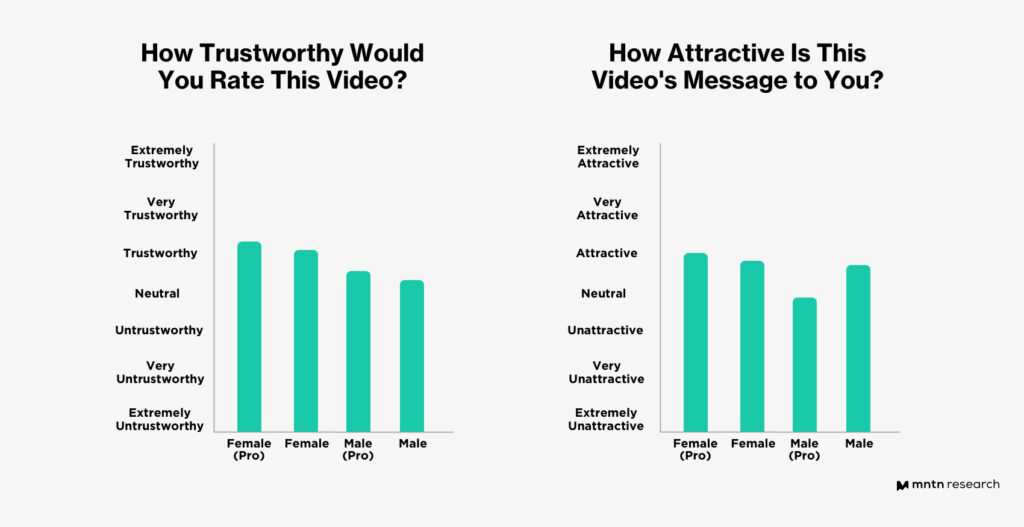Analysis
Number of Talent in TV Ads Can Positively Influence Overall Ad Performance
by Melissa Yap5 min read
Abstract
- A “more is more” approach to incorporating talent in a Commercial TV commercial drives better site visits and conversions.
- Advertisers should heed caution for voiceovers and speaking roles, where the “less is more” approach yields favorable results.
- Voiceover gender matters, with female voices evaluated higher than their male counterparts.
Research suggests specific combinations of ad creative elements produce specific outcomes and sentiment.

Is there such a thing as too many actors in a television commercial? Or too many speaking roles? We investigated the many creative elements that contribute to a high-performing commercial in our Video Vitals: What Makes the Perfect CTV Commercial? report, which analyzed over 1,800 ads across ad length, tone of voice, emotion, number of scenes and more.
Treading the Fine Line Between the Number of Actors Versus Speaking Roles
Casting talent can take up a chunk of a brand’s CTV commercial budget, yet advertisers have traditionally had difficulty quantifying the impact of casting decisions. The Video Vitals report findings provided insight into this, and revealed that brands should lean towards including more talent to feature in their commercials, as it has a positive correlation with both visit and conversion rates: both 15- and 30-second commercials saw peak performance when six or more actors were present throughout the creative.
While CTV’s popularity explosion has been a success story, it can be a complex market thanks to However, brands should also pay close attention to the number of speaking roles in their commercials as much as the number of casted talent. The “more is more” approach does not apply to the number of speaking roles. In fact, Connected TV commercials perform best when only around 50% of the on-screen talent have lines in a scene.

Gender Bias Exists in Television Commercials
Casting a certain number of talent in a commercial can work in advertisers’ favor, and as the scope of research is expanded into other studies, it’s clear that the type of talent matters too. Take gender as an example. Analysis reveals biases can surface within television advertising. Research conducted in 2017 by Advertising agency J. Walter Thompson and the Geena Davis Institute analyzed 10 years’ worth of audio and video content. It revealed that there are twice as many male characters as female characters in advertising. Additionally:
- 25 percent of ads feature just men, while only five percent of ads only feature women.
- 18 percent of ads feature only male voices, while less than three percent of ads feature only female voices.
- Women in ads are mainly between 20-40 year old age range, while male characters are featured across a wider age range.
- Women characters are 48% more likely to be shown in a kitchen scene, and male characters are 50% more likely to be shown at a sporting event.
Female Voice Overs Can Prove More Effective
Although female presence and portrayal has been underrepresented, they don’t fall short where voiceovers are concerned. A study conducted by the University of Strathclyde screened two types of advertisements—non-intimate products typically purchased by the female in the household (e.g. detergent, fabric softener etc) and intimate products that a female would buy for herself (e.g. cosmetics, deodorant)—to a sample audience of 79 women using both a female and male voiceover for each type of product. The results were then scored across a semantic differential scale.
Overall, the female voice was evaluated as more trustworthy, friendly and reliable, however, male voices scored higher across dominance for the non-intimate product (70 for the male versus 59 for the female voice). Additionally, the male voice scored higher on authoritarianism for the non-intimate ad (55 versus 37).

Similarly, another study conducted by CXL Institute, a premium marketing education provider, recruited 202 participants around the U.S., testing a promotional video using both female and male voice-overs. They were asked to evaluate both genders across traits like trustworthiness and attractiveness. Overall, participants trusted female voices more, and the professional male voice-over was rated least attractive.

This hypothesis was validated further when taking out visual cues completely, as research from Westwood One and Veritonic over 164 industry-winning video ads across a panel of 6,003 consumers found that female voiceovers outperformed across positive perception metrics like authenticity, happiness and uniqueness.

Conclusion
More actors drive better performance, however a “less is more” approach is preferred for speaking lines. When casting talent for their Connected TV commercials, advertisers should consider the gender biases that exist, as well as the emotive effects of female versus male voiceovers in their ad creative.
Subscribe to the MNTN Research Weekly
Sign up to receive a weekly feed of curated research, sent straight to your inbox.
Resources
1 Video Vitals Analysis Data (QuickFrame by MNTN)
2 Gender Bias in Advertising: Research Trends and New Visual Language (J. Walter Thompson and Geena Davis Institute on Gender in Media)
3 Which Type of Voice Actor Should You Use for Your Explainer Video? (CXL Institute)
4 How Creative Video Ads Build Brands (WARC)